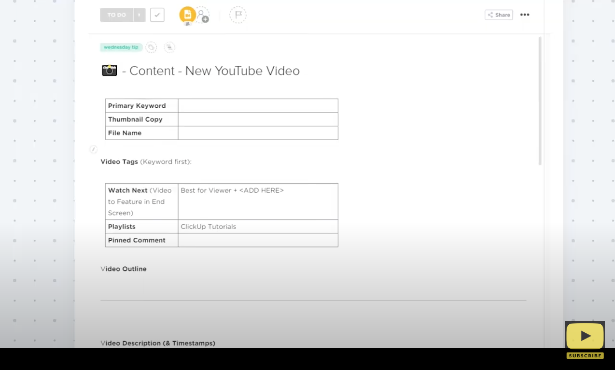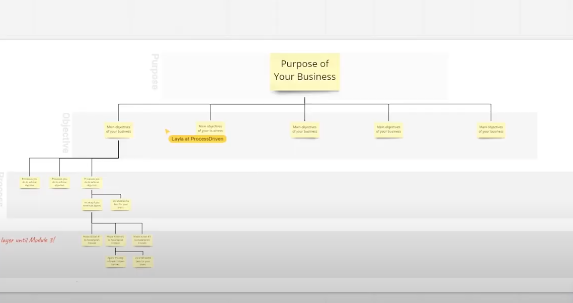Are you paralyzed trying to decide who should create business systems and SOPs in your business? Is it the owner? The manager? The employee?
In this video, Layla at ProcessDriven will break down WHO should be in charge of building a process-driven business. (Hint: It’s probably not who you think!)

What does “designing a process” really mean?

Who should be in charge of systemizing a business? Of creating a process handbook, a playbook, a series of standard operating procedures (SOPs) that is so clear that anyone could quit tomorrow and your business would still be okay?
(If you’re not sure the differences between Wiki’s, SOPs, and Policies check out this video here.)
To come up with a process, it’s important to start with listing out all the steps you need to do and in what order. For example, if you were going to record a YouTube video, you’d include things like turning on the lights, getting out your camera, setting up your recording software, etc.
Before you can create any business systems and processes, you’ll need to get the whole list of what it entails.
- Map – A few ways to map out your process: You could either a) simply wing it and observe yourself. Or you could b) use a flow chart and write out all the steps of a given process. Or c) create a checklist.
- Equip – This is when you have the system ready to follow through. You might need to tweak it here and there as you go, but you’re ready to start using the system you’ve created.
- Try – This step is where the rubber meets the road and you’re ready to do the process, figure out what’s right and wrong about it, and find ways to improve on it.
(Want to learn how to build SOPs directly into ClickUp? Check out our blog post here.)
Layla explains this in more detail starting at 0:16
The Map Stage is owned by the Business Owner and the Managers

The Map Stage should be a collaborative effort from both the owner and the managers.
Above you can see an example of what we call in the ClickingUp Community, a “Process Org Chart”.
Here, we describe the operations through the jobs to be done, grouped by objectives to fulfill the purpose of the business.
The top two layers of your Process Org Chart (or something similar) describe both the purpose and the main goals of your business. Those are the type of questions that owners and the key strategic leaders of the business need to be involved in, at least when it comes to defining and making sure they’re accurate.
Once we get past the purpose and the objectives, we focus on the core processes that really make the business hum.
What allows us to accomplish our objective of building amazing content?
What are the things that we’re doing on an ongoing basis that brings that to life?
Note: we’re not building any SOPs here. We’re really just figuring out what our business is all about. This is the stage where you want leadership to be heavily involved.
Layla dives into the Map Stage at 2:42
The Equip Stage is owned by the Managers and the Do-ers
The second step is the idea of equipping your processes and mapping the business systems.
This is where we want to see ownership shift a little bit. This is really one that is a combination of manager and do-er responsibility. So the owners are pretty much out of the picture at this point.
The “worker bees” (or you Virtual Assistants, hourly employees, etc.) should be leading this whole initiative. The manager’s job here is to cheerlead, set goals, and show support when necessary.
The people actually doing the work need to get their hands dirty with directing the flow and the general executing. Even if they don’t know how to set up ClickUp automations or know how to use Integromat (which is our go-to automation tool – you can check out our beginner tutorial on using ClickUp and Integromat here.)
The people in charge of certain tasks that affect the day-to-day workflow are so often focused on doing their job when they should be the ones directing it.
Some conversational questions the managers can ask here to get the ball rolling could include:
- What are you doing right now that is a waste of your time?
- How could we make that better?
- What could I be doing, whether it’s resources, time, a consultant I could pair you with, what can I do to make your work more enjoyable for you?
- What’s frustrating you?
- What’s not so great about your day-to-day work?
Layla dives into the Equip Stage at 3:54
The Try Stage is owned by the Managers
Once you have your business systems fleshed out, it’s time to put them to the test.
The final step of the process, which is the Try Stage. The manager owns this stage. The manager here is really looking at how things are being done and is keeping the feedback loop going between the other stages.
It’s up to the manager to keep an eye on possible bottlenecks and things that are taking too long.
Let’s say you’re a manager and you see that a ton of emails are being rewritten manually.
Ask yourself: “Based on the objective of the business, (which is set by the owner), how do manually written emails fit in? What department does that fall into? Manually writing emails really help us with our customer service delivery. That’s what the emails are about.”
Then take these concerns to your team members and say, “Hey team, so I notice you’re writing a lot of emails repetitively. How does that feel?” Most likely, if your team members are being honest, they’ll probably say something like, “Oh, my email is so frustrating and I hate it, I spend all day trapped in the inbox and it’s so frustrating.”
As the manager, you would want them to start focusing on things such as templates and keeping those templates in one central place because this could make their workflow easier. Small changes like adding templates to your team’s email workflow could cut their time writing the same emails over and over down by a significant chunk.
While it’s not the manager’s job to sit and write the templates, they can encourage and provide assistance where necessary.
Managers would ideally keep going until something else catches their eye and then the cycle begins again.
Layla goes over the Try Stage at 6:32
Short Answer: Everyone Needs to be Involved to Build Business Systems
Each layer of the team needs to be involved at some point to build these systems. It’s a collaborative effort!
The do-ers at the Equip Stage are going to be driving the force in your business systems. In the Try stage, the Managers are taking charge. By soliciting feedback, measuring results, and starting new conversations, they keep that cycle continuously improving with each step.
Related Resources
➤ Subtasks vs. Checklists vs. Descriptions | Beginner ClickUp tutorial to make SOPs and templates
